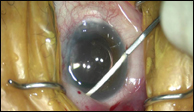Impact of phaco plus goniosynechialysis minimal in well-controlled glaucoma
Varying decreases in peripheral anterior synechiae did not adversely affect IOP.
In patients with medically well-controlled chronic angle-closure glaucoma and cataracts, combined phacoemulsification and goniosynechialysis rather than phaco alone did not significantly affect the IOP-lowering effect, according to a study.
“I tend to perform synechialysis along with cataract surgery empirically for patients with chronic angle-closure glaucoma (CACG),” co-investigator Chan Yun Kim, MD, PhD, who sought to determine if such a regimen had a substantial clinical impact on patient outcomes, said.
The study of 30 eyes, which appeared in the Journal of Glaucoma, prospectively randomized 15 eyes each to either phaco alone or combined phaco and goniosynechialysis (PEGS).

Technique challenges
“I think it is important to gently perform goniosynechialysis in order to minimize bleeding,” Kim, glaucoma section chief at the Institute of Vision Research, Yonsei University College of Medicine in Seoul, Korea, told Ocular Surgery News. “When bleeding occurs, inflammation can follow, and that can cause synechiae to form again.”
“PEGS not only removes [peripheral anterior synechiae] but can push back the iris root insertion. Hence, if performed a little too forcefully, PEGS can cause complications such as bleeding,” Kim said.
Kim also cautioned against pushing in the blunt cyclodialysis spatula too far.
“The spatula should be inserted only until the tip is just visible,” he said. “This is to prevent secondary damage to the iris and consequent inflammation.”

Image: Kim CY
Effect on anterior chamber depth
The combined group failed to show a significant improvement over phaco alone for parameters such as IOP, peripheral anterior synechiae (PAS) and number of glaucoma medications needed. The one exception was anterior chamber depth, which was greater in the combined group: 4.06 mm postop in the combined group vs. 3.5 mm postop in the phaco group.
Kim said anterior chamber depth is one of the factors that can affect IOL power calculations and subsequently affect visual acuity by causing refractive errors.
“However, in our study, the focus was on the correlation with IOP, so the effect on refractive errors was not studied,” he said. “Overall, goniosynechialysis does not seem to be essential for patients whose CACG is well controlled with medication.”
The average peripheral anterior synechiae, which was greater than 180° preoperatively for both groups, decreased to 62° after phaco alone and 95° after PEGS. But Kim said he was surprised that “the two groups showed no significant difference in IOP. This indicates that in medically well-controlled CACG, even phaco alone can decrease the degree of PAS and thus cause a drop in the IOP.”
Although the difference in decreased peripheral anterior synechiae did not differ substantially between the two groups, mechanical separation could have caused some damage to the angle structure, resulting in inflammation and a recurrence of peripheral anterior synechiae, Kim said.
“While PAS does tend to recur, the degree of recurrence is too small to be clinically significant,” he said.
According to the current report and some previous studies, “PEGS seems to be more effective in patients whose IOP is harder to control, whose preoperative IOP is very high and whose degree of PAS is wider,” Kim said. On the other hand, in cases in which chronic angle-closure glaucoma is well controlled with medication, “even just phaco alone can result in a favorable postoperative IOP.”
Kim said it is likely that the combination surgery is more beneficial in patients with uncontrolled chronic angle-closure glaucoma than phaco alone because combined surgery seems to not only affect IOP but also results in anterior chamber deepening.
“It might be worthwhile to investigate its effect on refractive errors and also visual acuity for a more accurate surgery,” he said.
Kim eventually plans to conduct a large-scale clinical study of phacoemulsification with goniosynechialysis and phaco alone in glaucoma patients with a longer follow-up. – by Bob Kronemyer
- Reference:
- Lee CK, et al. J Glaucoma. 2015;doi:10.1097/IJG.0000000000000043.
- For more information:
- Chan Yun Kim, MD, PhD, can be reached at Department of Ophthalmology, Institute of Vision Research, Yonsei University College of Medicine, 134 Shinchon-dong, Seodaemun-gu, Seoul 120-752, Korea; email: kcyeye@yuhs.ac.
Disclosure: Kim reports no relevant financial disclosures.
